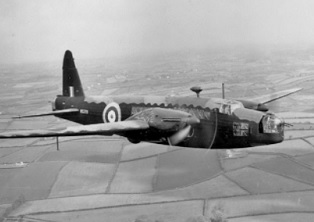| Date: 1941 Apr 09/10 | A/C Type: Wellington II | SN: W5375 | Code: PH-D | A/C Nickname: |  |
|||||
| File: 221 | Airforce: RAF | Sqn/unit: 12 sqn | Mission/Raid: Emden | |||||||
| 1 | Pilot | Wing Commander Vyvian Q. Blackden (Lemmer) | 9 | |||||||
| 2 | Nav | F/O John Du Vernet Broughton (Lemmer) | 10 | |||||||
| 3 | WO/AG | P/O John C.A. Bond (Bergen aan Zee) | 11 | |||||||
| 4 | AG | F/O Harold Marshall (Harderwijk) | 12 | |||||||
| 5 | WO/AG | Sgt. George H. Bishop (Urk) | 13 | |||||||
| 6 | WO/AG | Sgt. Duncan McDougall (Urk) | 14 | |||||||
| 7 | 15 | |||||||||
| 8 | 16 | |||||||||
Crashed in the northern part of Lake IJsselmeer (Old Zuyder Sea), between Medemblik and Lemmer, time 01:00u. Cause: Nightfighter Oblt. Egmont Prinz zur Lippe-Weissenfeld (Grid 5342). All 6 crew recovered and buried. |
||||||||||
Wellington W5375's early crash (April 1941) is very representative for what would follow in the years to come: RAF bombers shot down over the Lake at night, no survivors and crew washed ashore and buried in different locations around the Lake. This aircraft came down north part in the Lake, as one of the first. Many would follow. Crash location: square Enkhuizen-Stavoren-Lemmer.-Urk. The crew were found on a horizontal line, west and east of the crash location.
Wireless operator P/O John Bond is buried in Bergen aan Zee. This indicates that he was found or brought in by a fisherman on the north-western shore of the Lake between Enkhuizen and Den Oever (it was Andijk). He was buried in Bergen on row 1, between May 12th and June 13th 1941.
Wind came predominantly from the west and drove the other crew members slowly towards Lemmer and the Northeastpolder dike. Six weeks after the crash, Flying Officer John Du Vernet Broughton was recovered by the lifeboat 'Hilda' from Lemmer and buried Lemmer 28 June 1941. He was buried as first airman on the Lemmer war graves plot, on the first row (back row), near the morgue/tool shed, first grave left.
A month later, his pilot, Wing Commander Vyvian Q. Blackden also washed ashore at Lemmer. He was buried as third airman in the Lemmer war graves plot, in the centre of the back row. In the next four years, the whole plot in front of the grave of W/C Blackden became full with washed ashore Allied airmen. They were gradually buried in wider rows every time (necessity). In this way, the plot got the shape of a tree, with the oldest graves in the top. And in the peak of the tree, as in an organogram, is laying the highest ranking officer, Wing Commander Blackden. As a commanding officer watching over the 44 RAF airmen in this field of honour.
The first person recovered of the W5375 crew, involved Sgt. Duncan McDougall, May 21, 1941. His body lay on the bottom of the Lake and he was fished-up in the trawl net ('kuul') of the UK38 by skipper K. Wakker. Buried in Urk on May 25th 1941, as first Allied airman on this former island. The funeral was attented by the whole village. He could not be identified, on the grave-monument was engraved 'D.Mc.D'. Our research on the 25 airwar graves in Urk (exhumed 1947), revealed 'D.Mc.D' had to be Sgt. Duncan McDougall. He now rests in cemetery Amersfoort 'Rusthof' in Leusden-Zuid.
Flying Officer Harold Marshall's body passed the Northeastpolder dike and drifted further south where it washed ashore or was found by a fisherman from Harderwijk. Buried in Harderwijk on 14 July 1941 as second airman on this cemetery (43 to follow...). The first airman buried in Harderwijk was Sgt. Gordon W. Brown, also crashed in the Lake in a Wellington (R1440), same night as Marshall. Brown was recovered by a fisherman only a few days earlier on 10 July 1941. Five crew of Brown's Wellington R1440 are MIA, aircraft is never found.
In 2012, the historical society Harderwijk erected a monument in the Lake, on the their waterfront, representing the tail of a Wellington bomber to commemorate all WW2 Lake casualties. Link: ZZAirwar - Cemetery Harderwijk city Allied war graves plot
Last person to be recovered of the Blackden crew, was Sgt. George Bishop. His remains washed ashore at a construction site in Urk harbour (sluice Urkervaart, near pumping station Vissering -> where mr. Dirk de Boer was working, see ZZairwar News, 09 May 2021). Sgt. Bishop's body was in the water for five summer months and was in terrible state. He was buried 10 September 1941 as 'Unknown English Flyer' as first in an empty section of the Urk-cemetery. During the war this cemetery-section became known as 'The English Corner' because of the 23 airmen buried here. Later in the war it also ontained a number of American airmen. All airwar graves in Urk were exhumed in 1947. Today Sgt. Bishop rests in Amersfoort 'Rusthof', not far from his crewmember Sgt. Duncan McDougall.
The above is the result of years of research by us and others around the Lake.
Sources:
- http://www.teunispats.net/t991.htm
- Stichting Urk in Oorlogstijd, Pieter Hoekstra, Robert Hofman, e.a.
- cemetery files
- website CWGC
© ZZairwar (Zuyder Zee Air War)